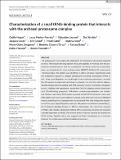Characterization of a small tRNA-binding protein that interacts with the archaeal proteasome complex
Abstract
The proteasome system allows the elimination of functional or structurally impaired proteins. This includes the degradation of nascent peptides. In Archaea, how the proteasome complex interacts with the translational machinery remains to be described. Here, we characterised a small orphan protein, Q9UZY3 (Uniprot ID) conserved in Thermococcales. The protein was identified in native pull-down experiments using the proteasome regulatory complex (PAN) as bait. X-ray crystallography and SAXS experiments revealed that the protein is monomeric and adopts a β-barrel core structure with an Oligonucleotide/oligosaccharide-Binding (OB) fold, typically found in translation elongation factors. Mobility shift experiment showed that Q9UZY3 displays tRNA binding properties. Pull-downs, co-immunoprecipitation and ITC studies revealed that Q9UZY3 interacts in vitro with PAN. Native pull-downs and proteomic analysis using different versions of Q9UZY3 showed that the protein interacts with the assembled PAN-20S proteasome machinery in Pyrococcus abyssi cellular extracts. The protein was therefore named Pbp11, for Proteasome Binding Protein of 11 kDa. Interestingly, the interaction network of Pbp11 also includes ribosomal proteins, tRNA processing enzymes and exosome subunits dependent on Pbp11's N-terminal domain that was found to be essential for tRNA binding. Together these data suggest that Pbp11 participates in an interface between the proteasome and the translational machinery.
Citation
Hogrel , G , Marino-Puertas , L , Laurent , S , Ibrahim , Z , Covès , J , Girard , E , Gabel , F , Fenel , D , Daugeron , M-C , Clouet-d’Orval , B , Basta , T , Flament , D & Franzetti , B 2022 , ' Characterization of a small tRNA-binding protein that interacts with the archaeal proteasome complex ' , Molecular Microbiology , vol. 118 , no. 1-2 , pp. 16-29 . https://doi.org/10.1111/mmi.14948
Publication
Molecular Microbiology
Status
Peer reviewed
ISSN
0950-382XType
Journal article
Description
Authors acknowledge financial support from the French Agence Nationale de la Recherche (grant [ANR-18-CE11-0018-01] to B.F. and [ANR-16-CE12-0016-01] to B.C.O). This work used the platforms of the Grenoble Instruct-ERIC Centre (ISBG: UMS3518 CNRS-CEA-UGA-EMBL) with support from FRISBI (ANR-10-INBS-05-02) and GRAL, a project of the University Grenoble Alpes graduate school (Ecoles Universitaires de Recherche) CBH-EUR-GS (ANR-17-EURE-0003) within the Grenoble Partnership for Structural Biology. The IBS Electron Microscope facility is supported by the Auvergne Rhône-Alpes Region, the Fonds Feder, the Fondation pour la Recherche Médicale and GIS-IBiSA.Collections
Items in the St Andrews Research Repository are protected by copyright, with all rights reserved, unless otherwise indicated.

